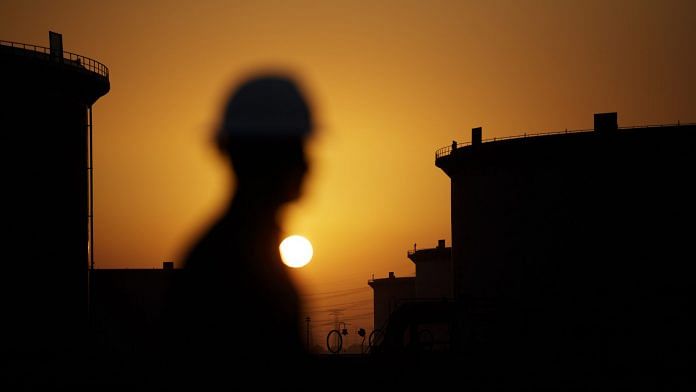Oil prices are rebounding thanks to an extended OPEC+ production cut, a surge in demand as economies recover from the coronavirus pandemic, and the beginning of a supply reaction from a year of both diminished production and inventory draw-downs. This is good news for the oil producers of the Gulf Cooperation Council.
But we should resist the temptation to equate this price spike to surges of the past, particularly the so-called “magic decade” between 2003 and 2014. Even at $70 a barrel, the current prices do not meet fiscal break-even thresholds for most Gulf Arab states. The gap between revenue and fiscal expenditure has been so wide since 2015 that the rebound won’t alter the basic fact that governments need to find new sources of revenue.
It is telling that Saudi Arabia is betting competition from U.S. shale will not reignite. This means they can focus on market share and relationship-building with key Asian customers without fear of resurgent American production. An eco-friendly Biden administration also fits into that calculation.
We are approaching an energy inflection point in the global economy: plentiful oil supply, a demand plateau by 2030 and more competitive renewable-energy options, even as investors and consumers grow more leery of carbon-intensive products. The future of the GCC is still one in which oil revenues fail to meet growth goals of governments, with a knock-on effect on job expectations of citizens.
In other words, if there is an oil boom this year, it may well be the last.
In the short-term, if OPEC+ holds its nerve and Saudi Arabia carries the lion’s share of the production cuts, oil prices at $70 a barrel through 2021 will create a much-improved growth outlook for the Gulf states. It will not be an even picture, however. Non-OPEC members Qatar, Bahrain and Oman will enjoy the benefits of increased production and higher prices. Even so, Bahrain and Oman are unlikely to avoid fiscal deficits this year, even with dramatic budget consolidation measures in place. Saudi Arabia and Kuwait also face continued deficits in their fiscal balances.
The spike in prices will add pressure from citizens — and even expatriates — on governments to provide financial support and pandemic stimulus measures. GCC states risk backtracking on policies to rationalize utility prices and curtail their public-sector wage bills.
The gap between revenues and expenditure, even allowing for significant cuts made over the past year, will continue to define Gulf states’ public finances. Over the past six years, that gap has been filled by borrowing, which did not slow down even through 2020, with Gulf issuance increasing by 35% from 2019.
It will be instructive to see how the GCC states use this last oil boom to pursue foreign-policy goals in their immediate neighborhood, and development strategies that link their economic futures to the growth of densely populated emerging markets farther afield. What political outcomes can Gulf states consolidate in the Horn of Africa and the Middle East? How will their competition for customers in India and China play out?
Seizing the opportunity created by the boom may require keeping others from the party, which means the dominant OPEC+ members will be loath to allow increased production from countries like Iran, Iraq, Libya and Venezuela. The Saudis, in particular, will continue to resist Iran’s economic and political rehabilitation.
In the medium-term, the ability to dominate energy markets, and not just oil, will be a strategic imperative, and probably the best place to reinvest any windfalls from the current upcycle. For the Saudis, energy diversification has meant building refining capacity in strategic locations like India and chemical plants in Texas, as well as developing a liquified natural gas business and being a first mover in green hydrogen technology.
The smart money will be on doubling down on strategic investments in a post-oil future and dedicating some increased government spending to immediate job creation and support for a private sector. The smaller GCC members, with fewer citizens to support, will enjoy a competitive advantage in labor markets, being better able to attract and retain highly skilled foreign workers. Punitive workforce-nationalization measures and efforts to strong-arm companies to move their headquarters will be counter-productive.
The ripple effects of an oil boom in the Gulf have long defined the economic health of the wider Middle East, impacting everything from aid to remittances and investment flows. But any windfall for GCC states this year will more likely be used to consolidate domestic policy gains and for growth in energy markets, mostly in Africa and Asia. They will have little money or energy to help Arab economies in distress, like Syria or Lebanon. If this is oil’s last hurrah, it will not ring across the region. –Bloomberg
Also read: Saudi Arabia’s oil hawkishness is forcing India to look for other sources






